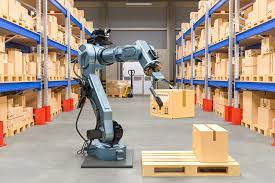This is a simple banner
Lorem ipsum dolor sit amet, consectetuer adipiscing elit, sed diam nonummy nibh euismod tincidunt ut laoreet dolore magna aliquam erat volutpat.
Smart warehouse is a warehouse system with high automation and advanced technology. It uses various technologies such as IoT, AI, robotics, and advanced data analytics to optimize operations. These warehouses are designed to deliver efficiency and accuracy in inventory management, order fulfillment and overall logistics. They significantly reduce manual work, improve accuracy in inventory levels and order processing, and can adapt quickly to changes in demand or inventory conditions. Smart warehouses represent the future of logistics, providing streamlined operations and enhanced supply chain management capabilities.
A smart warehouse system is a system that integrates advanced technologies such as automation, data and artificial intelligence to optimize warehouse operations. The main components of the smart warehouse system include:

Transport robots are used to transport goods in factories and warehouses. They are used to move pallets, crates, and other items.

Autonomous forklifts, also known as AMRs, are a type of forklift that is controlled automatically by software and sensors. They are used in warehouses and factories to transport goods automatically

An automatic conveyor is a piece of freight equipment used in factories, warehouses, and other manufacturing environments. They are used to transport goods from one location to another, such as from a receiving area to a storage area or from a storage area to a packaging area.

An automated racking system is a system that uses robots or other automated equipment to store and remove goods from shelves. They are used in warehouses and factories to improve efficiency and safety.
There are many different types of automated racking systems, each designed to perform a specific task. Some popular types of automated racking systems include: Low-range automated racking systems (VLS), High-level automated racking systems (ASRS), Mid-range automated racking systems (MLS)

A warehouse management system is a warehouse management software designed to help businesses track and manage their inventory.

Sensor systems are used to collect data about warehouse operations, such as goods location, temperature, humidity, etc. This data is transmitted to the WMS system for analysis and processing.

The data system is the place to store and process data collected from the sensor system. This data is used to analyze, optimize warehouse operations and make business decisions.

Artificial intelligence systems are used to analyze data, make predictions, and optimize warehouse operations. Popular artificial intelligence technologies in smart warehouse systems include: Machine Learning, Big Data Analytics, Artificial Intelligence
Smart warehouses, powered by automation, robotics, and data analytics, are revolutionizing the logistics and supply chain industry. By embracing cutting-edge technology, these facilities offer a plethora of benefits that optimize operations, boost efficiency, and ultimately drive profitability
Automated Storage and Retrieval Systems (ASRS): Robots and cranes whiz around, retrieving and storing pallets from high-density racks, significantly reducing manual labor and errors
Real-time Tracking: Sensors embedded in shelves and pallets provide instant location data, eliminating the mystery of misplaced items
Modular Design: Smart warehouse components are often modular and scalable, allowing you to easily adjust your system to accommodate changing demand or product lines
Reduced Labor Costs: Automation replaces manual tasks, leading to significant reductions in labor requirements and associated costs
Automatic storage and retrieval system (ASRS) of VNATECH smart warehouse
Uses a variety of robots and cranes, from mini-loaders for small items to towering giants for heavy pallets
Ensuring storage and Seamless access across a variety of product sizes.
Warehouse Management System, providing real-time inventory tracking, order fulfillment management, and data-driven insights to optimize Optimize workflow and resource allocation
Automated guided vehicles
Smart, self-driving vehicles move autonomously inside warehouses, transporting goods between designated points
Automatically controlled autonomous vehicles
Automated conveyor system